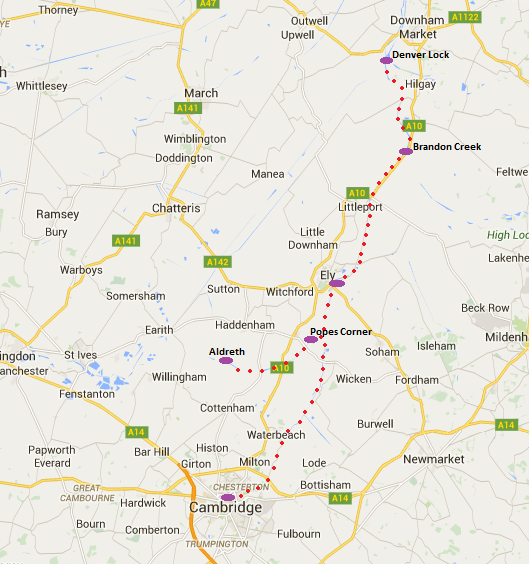From Fotheringhay the River Nene continued to wind in a northerly direction to Wansford giving us a good view of the surrounding countryside. Our moorings for the night were on the Environment Agency pontoon near the Nene Valley Steam Railway. There weren't any trains running that day but we were able to have a look round the station.
 |
| Steam engines at Nene Valley |
The next day we sailed into Peterborough and pulled up on the long line of moorings known as 'The Embankment'. ASDA is a short walk and the city centre is just a little further. Peterborough Cathedral is a magnificent building with an enormous frontage and fan-shaped ribs in some of it's ceilings.
 |
| Ribbed ceilings in Peterborough Cathedral |
The Nene is navigable to The Wash but Peterborough is our last stop on the river; we've booked passage through Stanground Lock which takes us onto the Middle Levels. The Middle Levels are essentially a series of drains through which there is a link route to the River Great Ouse. These waters are controlled by the Middle Level Commissioners and at Stanground we had to buy a windlass to fit their locks and a key for the facilities. The lock-keeper also gave us an information leaflet containing a small map and then we were on our way. The first drain, Kings Dike, gave us unexpectedly good views across the flat Fens and took us to the small town of Whittlesey.
 |
| A view of the flat Fenlands |
 |
| Straw man on a roof in Whittlesey |
After Whittlesey our view of the Fens was blocked by the higher banks of the Whittlesey Dyke but it was interesting to see a local rotary club had erected a sign to mark the Greenwich Meridian. On arrival in March we pulled up to the waterpoint only to find our key did not fit the lock. We decided to move onto the nearby visitor moorings and check where we could buy another key. Luckily the local council office on the High Street sell them but they were closed that day. The next morning we bought another key and reversed Brent III back to the facilities only to find the new key didn't fit either. To make matters worse the facility yard was fenced off and the gate locked so we could only access it by boat. So to return the key we had to either sail Brent III back to the moorings or climb over the fence. So over I went, much to the surprise of an elderly couple on the other side. It was third time lucky with the key but in the meantime Kev had phoned the Middle Level Commissioners who were prepared to send someone out to assist us.
The Chinese take away in March will be remembered for the wrong reasons. My chow mien was mediocre but Kev's special curry was something else. Instead of a selection of meats in his curry Kev found just mushrooms and onions.
 |
| Leaving March |
From March we picked up some speed along the Old Nene which again had high banks on either side.
 |
| Looking up the Twenty Foot River at it's junction with the Old Nene. |
At Marmont Priory Lock the lock-keeper advised Salters Lode Lock is tidal and the lock out tomorrow would be at 8.30am. As we were halfway between March and Salters Lode we decided to complete the journey that day. After leaving Marmont Priory the Old Nene changed from a wide deep watercourse to a narrow, shallow channel winding through the villages of Upwell and Outwell.
 |
| Upwell. A busy A-road runs between the houses and the river but there is no fence or other barrier. |
Some of the bridges are very low.
 |
| It's a tight fit! |
The river became very shallow and we kept picking up rubbish around the propeller. Then it became apparent we were dragging something along but couldn't reach it through the weedhatch. We plodded along until Kev reversed as we approached the Salters Lode pontoons. A noisy vibration indicated whatever we were dragging was now around the propeller. Up with the weedhatch again to find a plastic tarpaulin.
We awoke to heavy rain the next morning and were the first boat into Salters Lode Lock. The lock has a low bridge across it so we had to wait until the tide had turned and the water in the River Great Ouse had dropped sufficiently before the water level in the lock could be raised. Torrential rain came down as we waited in the lock but eventually the gate was raised and out we went making the sharp turn upstream to Denver Lock.
 |
| Waiting in Salters Lode Lock - before the torrential rain. |
We travelled the short distance up the Great Ouse and into Denver Lock which was already open for us. The lock-keeper advise there were moorings through the lock and that is as far as we went.
Our journey from Fotheringhay to Denver Lock





































